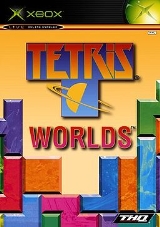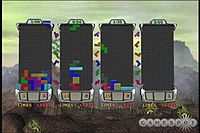
Tetris Worlds
Encyclopedia
Tetris Worlds is a version of the popular video game Tetris
. Originally released in 2001 for PC
and the GBA
, it later was released for the Xbox
, GameCube
, and PlayStation 2
in 2002. In 2003, an Xbox Live
capable and a single-disc compilation versions (which included this game and Star Wars: The Clone Wars was released for the Xbox. The latter was bundled with Xbox systems, however it is not forward compatible
with the Xbox 360
.
The game developed three different companies in each versions while THQ published it. Blue Planet Software
developed the PC and PlayStation 2 versions, Radical Entertainment
developed the GameCube and Xbox versions, and 3d6 Games
developed the Game Boy Advance version.
games. However, there are several game modes, tweaking the way the game works.
 This mode is where the player plays two-minute Tetris games of any variant. This is also where multiplayer games are played. The Arcade mode variants are listed as follows:
This mode is where the player plays two-minute Tetris games of any variant. This is also where multiplayer games are played. The Arcade mode variants are listed as follows:
In the PS2, PC, and GBA versions, gameplay contained one major difference from a normal Tetris game. In classic Tetris, when a Tetrimino touches the bottom of the screen, it locks in place. However, in these versions, the Tetrimino does not lock until the player makes it lock, allowing him/her to rotate and move the piece until the player liked it the way it was. Critics said that this made the game too easy and GameSpot
said that it "broke Tetris". However, the GBA version features a hidden version of classic tetris (titled "Popular" tetris) that plays without this feature. It is accessed by holding the L button and pressing select on the "Marathon" game select menu. However, since it is not part of the "Default" presentation, many reviews did not factor in this mode.
In the GameCube and Xbox versions, the "Easy Spin" feature was made optional. However, they still received mostly mixed reviews, with the Xbox Live compatible version receiving the highest reviews.
Tetris
Tetris is a puzzle video game originally designed and programmed by Alexey Pajitnov in the Soviet Union. It was released on June 6, 1984, while he was working for the Dorodnicyn Computing Centre of the Academy of Science of the USSR in Moscow, Russian Soviet Federative Socialist Republic...
. Originally released in 2001 for PC
Microsoft Windows
Microsoft Windows is a series of operating systems produced by Microsoft.Microsoft introduced an operating environment named Windows on November 20, 1985 as an add-on to MS-DOS in response to the growing interest in graphical user interfaces . Microsoft Windows came to dominate the world's personal...
and the GBA
Game Boy Advance
The is a 32-bit handheld video game console developed, manufactured, and marketed by Nintendo. It is the successor to the Game Boy Color. It was released in Japan on March 21, 2001; in North America on June 11, 2001; in Australia and Europe on June 22, 2001; and in the People's Republic of China...
, it later was released for the Xbox
Xbox
The Xbox is a sixth-generation video game console manufactured by Microsoft. It was released on November 15, 2001 in North America, February 22, 2002 in Japan, and March 14, 2002 in Australia and Europe and is the predecessor to the Xbox 360. It was Microsoft's first foray into the gaming console...
, GameCube
Nintendo GameCube
The , officially abbreviated to NGC in Japan and GCN in other regions, is a sixth generation video game console released by Nintendo on September 15, 2001 in Japan, November 18, 2001 in North America, May 3, 2002 in Europe, and May 17, 2002 in Australia...
, and PlayStation 2
PlayStation 2
The PlayStation 2 is a sixth-generation video game console manufactured by Sony as part of the PlayStation series. Its development was announced in March 1999 and it was first released on March 4, 2000, in Japan...
in 2002. In 2003, an Xbox Live
Xbox Live
Xbox Live is an online multiplayer gaming and digital media delivery service created and operated by Microsoft Corporation. It is currently the only online gaming service on consoles that charges users a fee to play multiplayer gaming. It was first made available to the Xbox system in 2002...
capable and a single-disc compilation versions (which included this game and Star Wars: The Clone Wars was released for the Xbox. The latter was bundled with Xbox systems, however it is not forward compatible
Forward compatibility
Forward compatibility or upward compatibility is a compatibility concept for systems design, as e.g. backward compatibility. Forward compatibility aims at the ability of a design to gracefully accept input intended for later versions of itself...
with the Xbox 360
Xbox 360
The Xbox 360 is the second video game console produced by Microsoft and the successor to the Xbox. The Xbox 360 competes with Sony's PlayStation 3 and Nintendo's Wii as part of the seventh generation of video game consoles...
.
The game developed three different companies in each versions while THQ published it. Blue Planet Software
Blue Planet Software
Blue Planet Software, formerly known as Bullet Proof Software, is a video game developer and publisher. The original Bullet Proof Software was founded in Japan in the 1980s. Blue Planet Software was founded by Henk Rogers in Honolulu, Hawaii in 1996....
developed the PC and PlayStation 2 versions, Radical Entertainment
Radical Entertainment
Radical Entertainment is a video game developer based in Vancouver, British Columbia, Canada. It was founded in 1991 and previously developed games for game publishers such as THQ, Microsoft and Fox Interactive. It is now an entirely owned subsidiary of Activision Blizzard after being acquired by...
developed the GameCube and Xbox versions, and 3d6 Games
3d6 Games
3d6 Games was a video games development company based in Henderson, Nevada and founded in 1999. The company developed titles exclusively for GBC and GBA, and was best known for bringing Tetris to GBA in 2001 with Tetris Worlds....
developed the Game Boy Advance version.
The Tetrions
The Minos
The Mission
Gameplay
Gameplay consists of normal TetrisTetris
Tetris is a puzzle video game originally designed and programmed by Alexey Pajitnov in the Soviet Union. It was released on June 6, 1984, while he was working for the Dorodnicyn Computing Centre of the Academy of Science of the USSR in Moscow, Russian Soviet Federative Socialist Republic...
games. However, there are several game modes, tweaking the way the game works.
Story mode
The player can send their Mino Tetrinaut to six different worlds, where he/she plays the Tetris variant of that world. When the player plays enough of that world, more Minos are rescued. The better the player does, the more Minos rescued. They will then work to create the world into a home for Minos.Arcade mode

- Tetris: A normal Tetris game, where the player plays until he/she loses. Losses occur when the Tetriminos reach the top. "Go for a Tetris".
- Square Tetris: While the player plays Tetris, they also must try to combine Tetriminos into squares. Lines cleared containing 4x4 Tetriminos cause large bonuses. "Go for a Square".
- Cascade Tetris: The player must try to clear lines that cause Cascades. Cascades occur when a cleared line cause other Blocks to fall and clear another line. "Go for a Cascade".
- Sticky Tetris: Players must try to clear the bottom line of "Garbage Blocks". Same-colored Blocks stick together in this mode, hence the name. If 25 same-colored blocks connect, a Critical Mass is formed and are cleared from the Matrix. "Clear the Bottom Line".
- Hot-Line Tetris: In this mode, there are six "Hot-Lines" in the Matrix. The player must try to clear lines that are on the Hot-Line. Lines cleared anywhere else earn no points. "Go for a Hot-Line".
- Fusion Tetris: In this mode, there is a "Fusion Block" at the bottom of the Matrix. Players must try to connect falling "Atom Blocks" to the Fusion Blocks. Atom and Fusion Blocks are not cleared in line clears, and clearing a line containing an Atom or Fusion Block causes a Cascade. "Activate the Atom Blocks".
- Popular Tetris (GBA Version Only): In this hidden mode the game is set up the way the original Tetris game was. The player clears lines to score points and after every 10 lines the level goes up. Scoring increases on higher levels and there is no time limit, however this mode stops keeping score once a player reaches 1 trillion (which is more than 999999, the maximum score on the Gameboy version).
Reception
While Tetris Worlds did receive some good reviews; it generally received mediocre and negative reviews.In the PS2, PC, and GBA versions, gameplay contained one major difference from a normal Tetris game. In classic Tetris, when a Tetrimino touches the bottom of the screen, it locks in place. However, in these versions, the Tetrimino does not lock until the player makes it lock, allowing him/her to rotate and move the piece until the player liked it the way it was. Critics said that this made the game too easy and GameSpot
GameSpot
GameSpot is a video gaming website that provides news, reviews, previews, downloads, and other information. The site was launched in May 1, 1996 by Pete Deemer, Vince Broady and Jon Epstein. It was purchased by ZDNet, a brand which was later purchased by CNET Networks. CBS Interactive, which...
said that it "broke Tetris". However, the GBA version features a hidden version of classic tetris (titled "Popular" tetris) that plays without this feature. It is accessed by holding the L button and pressing select on the "Marathon" game select menu. However, since it is not part of the "Default" presentation, many reviews did not factor in this mode.
In the GameCube and Xbox versions, the "Easy Spin" feature was made optional. However, they still received mostly mixed reviews, with the Xbox Live compatible version receiving the highest reviews.

